Packera glabella (Poir.) C. Jeffrey
Butterweed

Native
CC = 1
CW = -3
MOC = 39
© DETenaglia
Packera glabella (Poir.) C. JeffreyButterweed | |
 |
Native CC = 1 CW = -3 MOC = 39 |
© DETenaglia |
|
Family - Asteraceae/Senecioneae Habit - Annual or sometimes biennial forb, from fibrous roots, lacking rhizomes. Stems - Erect, usually single, to 80 cm, usually appearing stout and somewhat inflated, hollow, ridged, often purplish near base, glabrous or inconspicuously hairy.
Leaves - Alternate, petiolate basally, sessile above, pinnately divided. Basal leaves usually absent at flowering, with a shallow adaxial groove along the petiole, glabrous at flowering, the blades 3-20 cm long, pinnately compound with several pairs of lateral pinnae, less commonly only pinnately lobed, oblanceolate to elliptic-obovate in outline, the lobes or leaflets rounded at the tip, sometimes deeply few-lobed, the margins otherwise scalloped or with blunt to sharp teeth, the surfaces glabrous. Stem leaves gradually reduced toward the stem tip, sessile or nearly so, the blades mostly deeply pinnately lobed, the lower leaves sometimes with the blades pinnately compound, the lobes or leaflets sometimes deeply lobed, the terminal lobe or leaflet broadly wedge-shaped to nearly circular, shorter than to about as wide as long, the margins otherwise scalloped or bluntly to sharply toothed, the surfaces glabrous.
Inflorescence - Terminal and axillary panicles of flower heads, usually flat-topped. Divisions of the inflorescence subtended by small attenuate bracts. Peduncles and pedicels of the inflorescence glabrous and carinate.
Heads - Involucre 4-7 mm long, 3-4 mm in diameter, glabrous. Involucral bracts in a single series, glabrous, green, acute, linear, 4-5 mm long, 0.8 mm broad, fused for most of their length. Receptacle flat, naked.
Florets - Ray florets usually 7-13, pistillate, the ligule 5-12 mm long, yellow, glabrous, 2-3-toothed at the apex, the corolla tube 4-5 mm long, greenish-white, glabrous, the style glabrous, 5 mm long, barely exserted. Disk 4-5 mm broad. Disk florets with the corolla tube 5 mm long, glabrous, white in the basal 2/3, yellow in the apical 1/3, expanded in the apical 1/3, 5-lobed, the lobes erect to spreading, acute, the 5 stamens adnate at the apex of the contracted portion of the corolla tube, mostly included, the style 1, glabrous, to 6 mm long, exserted just beyond the anthers. Pappus of white capillary bristles to 4 mm long. Achene white in flower, glabrous, cylindrical, 1mm long.
Fruits - Achenes 2.5-3.0 mm long, 2 mm long at maturity, brown, 4-5-angled, glabrous or more commonly hairy, especially along the ribs.
Flowering - April - June. Habitat - Bottomland forests, swamps, streambanks, sloughs, bottomland prairies, crop fields, railroads, roadsides, and moist, open, disturbed areas. Origin - Native to the U.S. Lookalikes - Broadly, other members of the Packera genus. Other info. - This striking species occurs in Missouri mostly in the Bootheel region and in counties which border the big rivers. Beyond Missouri its main range includes the southeastern U.S., though it also ranges as far north as Michigan and possibly Canada. The plant is relatively easy to identify by its showy, flat-topped clusters of yellow flowering heads and stout, hollow, ridged stems. It is a common weed in moist fallow agricultural land, and can form enormous populations of solid, bright yellow under favorable conditions. Photographs taken somewhere in Tennessee, 5-10-04 (DETenaglia); also in Weldon Spring Conservation Area, 5-22-2009, in Riverfront Park, Washington, Franklin County, MO, 5-5-2014 and 4-24-2025, Pacific Palisades Conservation Area, Jefferson County, MO, 4-2-2020, along the Katy Trail near Dutzow, Warren County, MO, 5-22-2020 (SRTurner). |